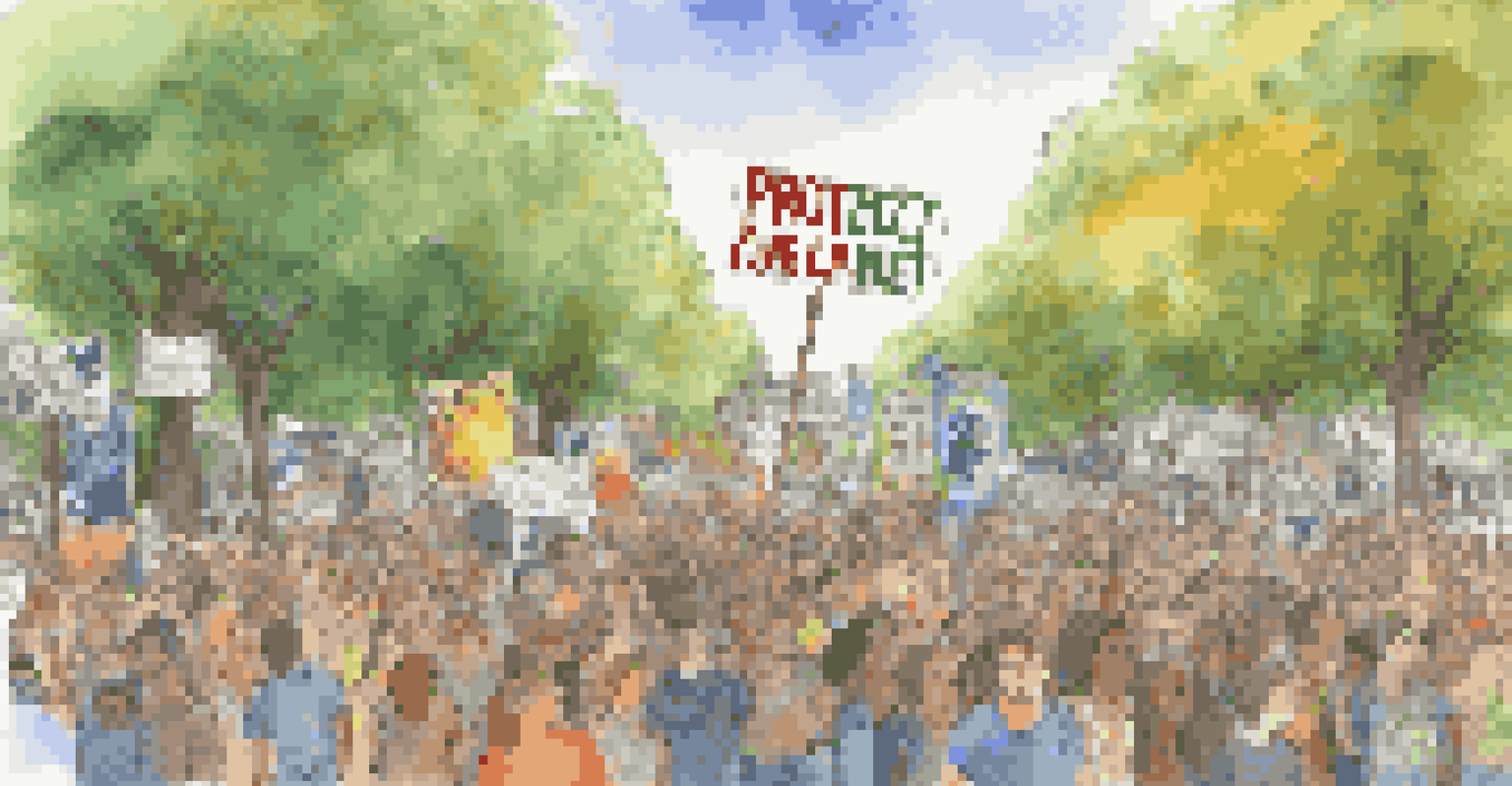The Influence of Protest Songs on Environmental Movements

The Historical Roots of Protest Songs
Protest songs have a rich history, often emerging during times of social upheaval. From the folk tunes of the 1960s civil rights movement to the anthems of anti-war protests, these songs serve as powerful tools for mobilization. They resonate with collective emotions, providing a voice to those who feel marginalized or ignored. This tradition has naturally extended to environmental issues, as activists seek to highlight the urgent need for change.
Music can change the world because it can change people.
A prime example is the song 'Big Yellow Taxi' by Joni Mitchell, which laments the loss of nature to urban development. Its catchy refrain and poignant lyrics have made it a staple in environmental discourse, illustrating how music can elevate pressing issues. By encapsulating complex feelings into relatable lyrics, protest songs make powerful statements that can galvanize entire communities.
As we delve into the influence of these songs on modern environmental movements, we see how they not only raise awareness but also inspire action. The emotional weight carried by music can push individuals to join protests, sign petitions, or change their habits, proving that art and activism often go hand in hand.
Connecting Emotion to Environmental Advocacy
One of the most compelling aspects of protest songs is their ability to evoke strong emotions. Songs like 'Mercy Mercy Me' by Marvin Gaye articulate the devastation of pollution in a way that statistics simply cannot. Through evocative imagery and heartfelt melodies, these songs touch listeners on a personal level, often prompting a deeper consideration of environmental issues.

When people connect emotionally to a cause, they are more likely to engage with it actively. For instance, a powerful protest song can serve as a rallying cry during demonstrations, uniting individuals under a shared vision of a healthier planet. This communal experience reinforces the idea that everyone has a role to play in the fight for environmental justice.
Moreover, the emotional resonance of protest songs can transcend generations, passing down the urgency of environmental advocacy. Young listeners today may discover classics from the past and feel inspired to join the movement, creating a continuous cycle of awareness and action that is vital for long-term change.
Modern Examples of Environmental Protest Songs
In recent years, artists have increasingly used their platforms to address environmental issues. Songs like 'Earth' by Lil Dicky not only entertain but also educate listeners about climate change. By harnessing humor and creativity, modern protest songs can reach diverse audiences, effectively spreading the message far and wide.
The power of music is its ability to unify and inspire, transcending barriers and igniting change.
Another notable example is 'Praying' by Kesha, which, although primarily about personal empowerment, touches on themes of resilience that resonate with environmental advocates. The song's message of standing up against adversity parallels the struggle against climate change, reminding listeners that they can make a difference.
These contemporary anthems often leverage social media to amplify their reach, allowing fans to share messages with just a few clicks. As music continues to evolve, its role in environmental movements remains vital, showcasing how art can remain relevant in advocating for change.
The Role of Music Festivals in Advocacy
Music festivals have become a vibrant platform for environmental activism. Events like Coachella and Glastonbury not only feature popular artists but also spotlight environmental organizations, creating a unique blend of entertainment and advocacy. By incorporating eco-friendly practices, these festivals encourage attendees to consider their impact on the planet.
At these festivals, protest songs often take center stage, uniting crowds in shared values and collective action. When a crowd sings along to a relevant anthem, the energy is palpable, reinforcing a sense of community and purpose. This shared experience can lead to greater awareness and inspire festival-goers to adopt more sustainable lifestyles long after the music fades.
Additionally, artists often use their performances to address environmental issues directly, urging fans to take action. This combination of music and activism fosters a culture of environmental consciousness, proving that festivals can be more than just fun—they can also be powerful catalysts for change.
The Influence of Social Media on Protest Songs
In the digital age, social media plays a crucial role in the dissemination of protest songs. Platforms like TikTok and Instagram allow users to share snippets of songs, often leading to viral trends that capture public attention. This phenomenon gives artists the chance to reach broader audiences, making their messages more impactful.
For example, the song 'This Is America' by Childish Gambino gained massive traction online, sparking discussions about social justice and environmental degradation. The power of social media means that protest songs can quickly become part of the cultural conversation, igniting movements and inspiring action across the globe.
Moreover, social media allows for a more interactive experience, where fans can engage with artists and share their own stories related to the themes in the songs. This communal engagement enhances the emotional connection to the music and amplifies the song's call to action, further solidifying the relationship between art and activism.
How Protest Songs Bridge Generational Gaps
Protest songs have a unique ability to bridge generational gaps, connecting the old with the new. Many young activists discover classic songs from their parents or grandparents, finding that the messages still resonate today. This shared musical experience fosters dialogue across generations, allowing different perspectives on environmental issues to emerge.
For instance, a young person might hear 'Where Have All the Flowers Gone' by Pete Seeger and feel inspired to take action against climate change, despite the song being decades old. This continuity shows how the themes of environmental advocacy are timeless and can inspire ongoing movements.
As modern artists reinterpret classic protest songs or create new anthems, they keep the spirit of activism alive. The blending of old and new not only enriches the musical landscape but also reinforces the idea that the fight for a healthier planet is a shared responsibility that transcends age.
The Future of Protest Songs in Environmental Movements
Looking ahead, the role of protest songs in environmental movements is likely to expand further. As climate change continues to threaten our planet, artists will undoubtedly find new ways to express their concerns through music. This ongoing evolution ensures that protest songs remain relevant, capturing the zeitgeist and motivating action.
The rise of diverse voices in music, from indigenous artists to global musicians, will also enrich the narrative around environmental advocacy. These perspectives can shed light on issues that may have been overlooked, fostering greater understanding and empathy within the movement.

Ultimately, the future of protest songs lies in their ability to adapt and resonate with audiences. By tapping into the collective consciousness, these songs will continue to inspire generations to stand up for the environment, proving that music is a powerful ally in the quest for justice.